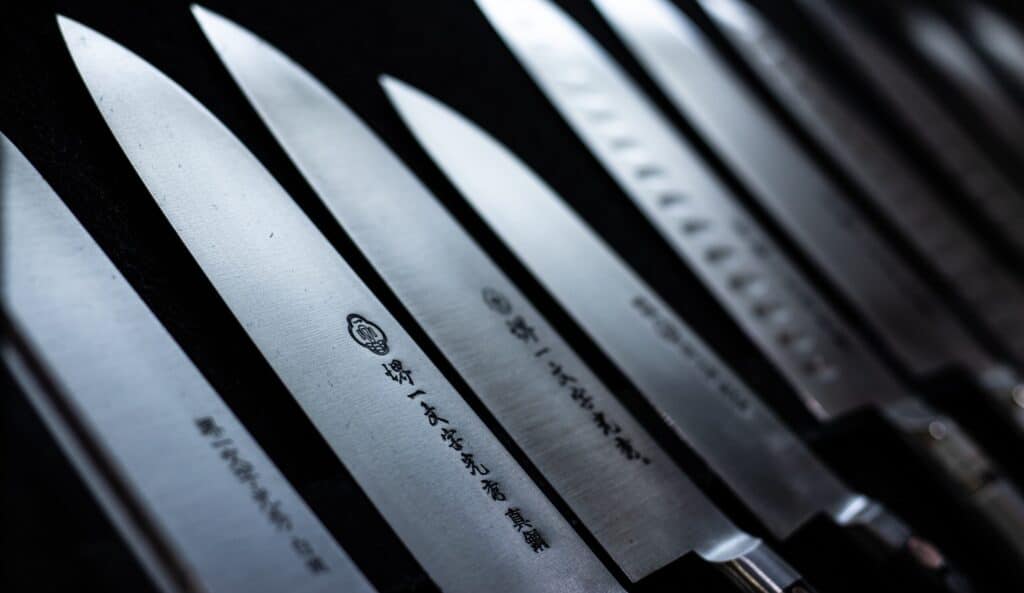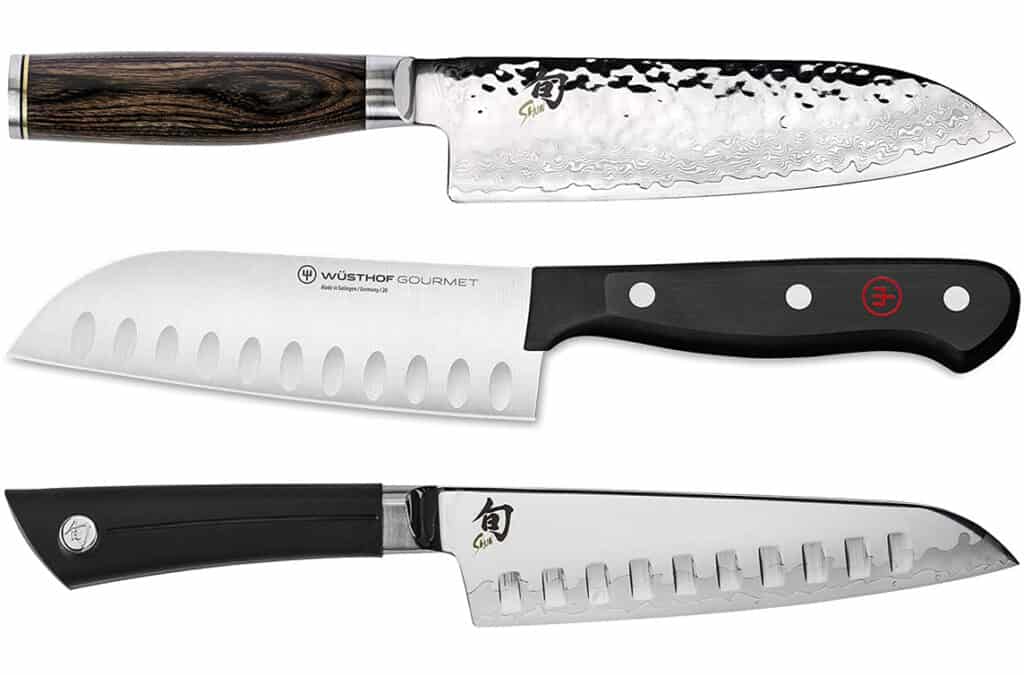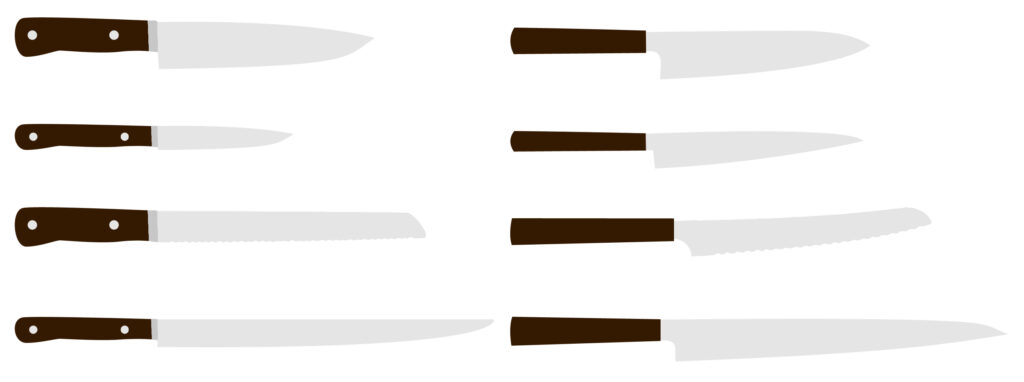
Japanese knives have loads of great benefits. They stay sharper for longer and they can be extremely attractive. But entering into the world of Japanese knives can be quite daunting. There seem to be hundreds of different types and the names… Well, let’s just say they are a little confusing.
But Japanese knives needn’t be as confusing as they first seem. In fact, most Japanese knives have a very similar western counterpart. In this article, I’ll look at the four popular types of Japanese knives and what their western counterparts are.
These four knives all perform key tasks in the kitchen and it should help you to understand some of the key Japanese knife types.
To start things off, here’s a simple table of the knife styles we’ll be looking at, with their Western name on the left and the Japanese equivalent on the right.
| Western Knife | Japanese Knife |
| Chef’s knife | Gyutou |
| Paring knife | Petty |
| Serrated knife | Pankiri |
| Carving knife | Sujihiki |
What is the difference between Japanese and Western-style knives
Before we delve into each knife type, it’s important to understand what the general differences between Japanese and Western kitchen knives are.
Japanese knives are crafted from harder carbon steel than western style knives. This gives them their main advantage, strength. Japanese blades are extremely strong, meaning that the blade can be thinner and the edge can be sharper than a western knife.
Typically a Western-style knife will have a blade angle of around 20 degrees, whereas a Japanese knife will have an angle of around 13 degrees and some even as small as 6 degrees.
There are other differences too, Japanese knives don’t have the bulky bolster that Westron ones do and the handles tend to be smaller. If you’re interested in learning more about the benefits (and some cons) about Japanese knives then I would recommend you check out an in-depth article I wrote about them here.
Gyutou / Chef’s knife
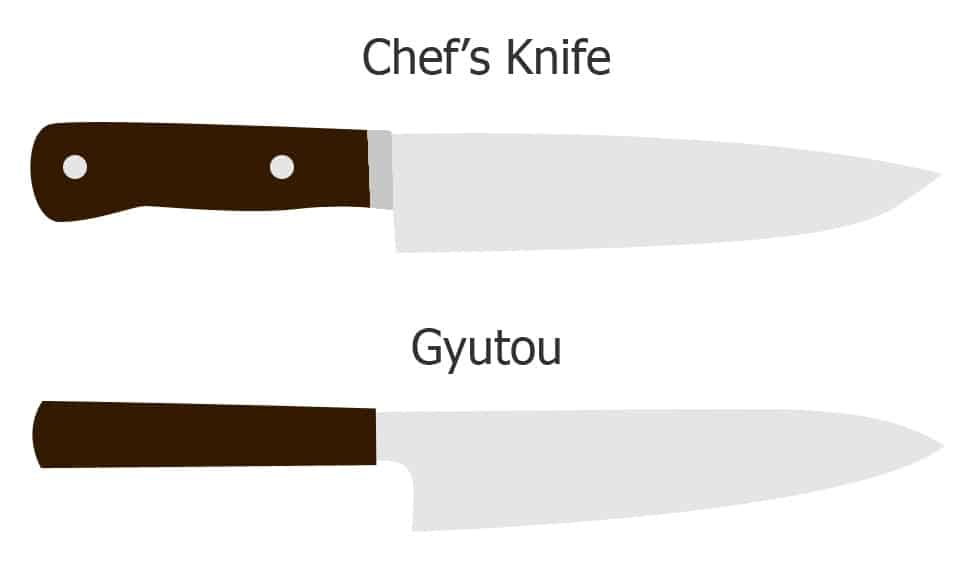
What is a Gyutou
Just like a chef’s knife, a Gyutou is an all-purpose knife suited to a range of tasks. You may also see it named without the U, as Gyuto, it’s the same thing so don’t worry (A bit like ‘chef knife’ and ‘chef’s knife’)
You’ll usually find Japanese knives measured in millimetres rather than inches. So if you’re an imperial person then here’s a knife size comparison guide:
| Millimetres | Inches |
| 180 | 7 |
| 210 | 8 |
| 240 | 9.5 |
| 270 | 10.5 |
| 300 | 12 |
| 360 | 14 |
The 180 to 240 Gyutou are the ones I would recommend for the home cook, although it really depends on your size. I wrote a whole article about how big your chef’s knife should be and how to choose the length here. The same principles also apply to choosing your Gyutou.
Why you need a Gyutou
The Gyutou is the perfect Japanese all-rounder and it’s the knife you’ll use most in the kitchen. If you just want to begin your exploration into Japanese knives then this is the one I recommend you begin with.
Its long wide blade makes it ideal for a whole range of chopping and slicing tasks. The Gyutou is great for cutting fruit, vegetables and meat. It’s lighter than a chef’s knife due to a thinner blade and lack of bolster, this makes it easier to handle and more comfortable over prolonged use. The thinner blade also means it’s easier to slice thin pieces of food.
However; whilst the blade is stronger than a western blade it’s also more brittle, therefore you need to be careful about cutting into anything with hard bits. The main danger is bones, you should avoid using a Gyutou to cut into meat containing bones as the impact could damage and chip the blade. This can be fixed by sharpening it but it’s best to avoid it altogether unless you are very comfortable with your knife skills and you won’t hit the bone.
How to use a Gyutou
The best way to hold a Gyutou is by using a technique called choking the blade, or the ‘pinch grip’.
With the handle in the palm of your hand, use your index finger and thumb to grip the heel end of the blade. This gives you more control over the blade than simply holding the handle and allows you to make faster and more precise cuts.
Japanese knives ten to have straighter blades than western ones, so the standard rocking chop motion you might use for a chef’s knife won’t be as effective with a Gyutou. Instead, you will need to do more precise slices when cutting.
How much you should spend on a Gyutou
The big question. Japanese knives can be super expensive. The Gyutou is the most important knife as it’s an allrounder, so I don’t think it’s worth spending a little more than you might do on your other knives. But I also believe you can get a great Gyutou for a pretty reasonable price.
This XINZUO 8.3 inch blade is a great knife and it doesn’t differ in price much from a quality chef’s knife. It’s sharp, a good size for all users and has a unique design.
If you want to go for something even more special then I would recommend this Yoshihiro VG-10 46. It’s 9.5 inches and an absolute beauty. Yoshihiro is a great brand and this is a top-quality knife for any home cook.
Petty / Paring knife
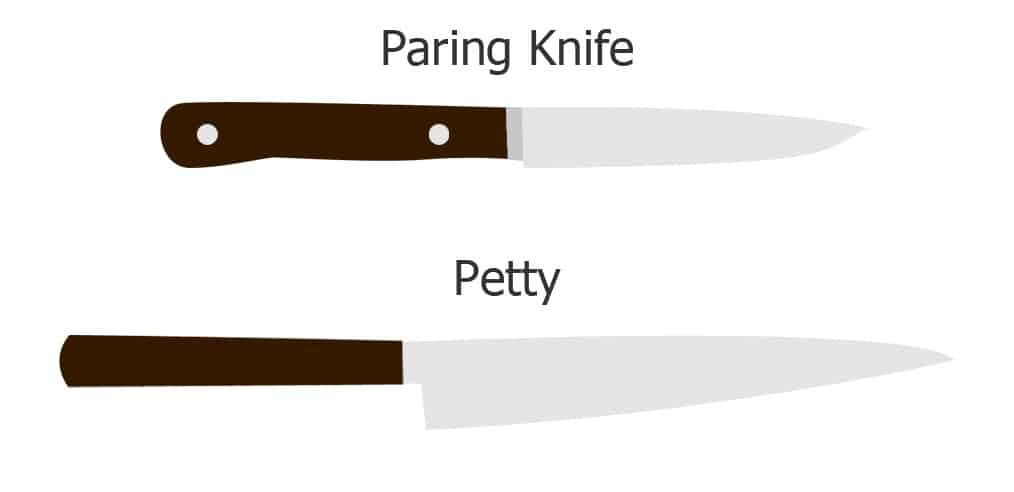
What is a Petty
A Petty is the go-to utility knife for smaller tasks which don’t require a knife the size of a Gyutou.
Petty knives are generally larger than paring knives, but smaller than the Gyutou, ranging in size from 120 to 180mm. Again I’ve made a comparison table below for those who prefer inches.
| Millimetres | Inches |
| 120 | 4.7 |
| 150 | 6 |
| 180 | 7 |
Paring knives typically range from 2.5 to 5 inches, so the largest paring knives are similar to the smallest Petty knives.
Why you need a Petty
Petty knives are ideal for smaller tasks, such as peeling fruit. They are also ideal for slicing smaller food such as strawberries and tomatoes with more precision than you could achieve with a larger knife.
Due to their larger size, I personally don’t think Petty knives are as effective at using in-hand as a paring knife would be. By that I mean the type of in-hand action you would use to peel a potato with a paring knife, this can be a little dangerous and cumbersome with a Petty.
However, I find that their slightly larger size does make them even more useful for plenty of other tasks, especially chopping and slicing. Sometimes a find paring knives too small for these tasks, so just go straight to a chef’s knife. The Petty offers a great intermediate size which we don’t really have in standard, western knife types.
How to use a Petty
When using a Petty I would recommend the choke technique, holding the blade firmly with your index finger and thumb with the handle in your palm. You should use slicing motions to cut the food, the blade of a Petty is quite flat so you won’t be able to do a rocking chop motion.
Peeling with a Petty in one hand and food in the other is possible, but I would recommend using a smaller 120 Petty and be very careful until you get used to it. Remember as well that Japanese knives are much sharper than western ones so take your time to get comfortable with this technique.
How much you should spend on a Petty
If you have a Petty you’ll probably end up using it quite a lot. Now, Japanese knives can be really expensive, but they don’t have to be. For a reasonably priced and quality Petty I would recommend the Shun Classic 6”.
It’s a good size at 6 inches, good quality and it looks beautiful.
Pankiri / Serrated knife
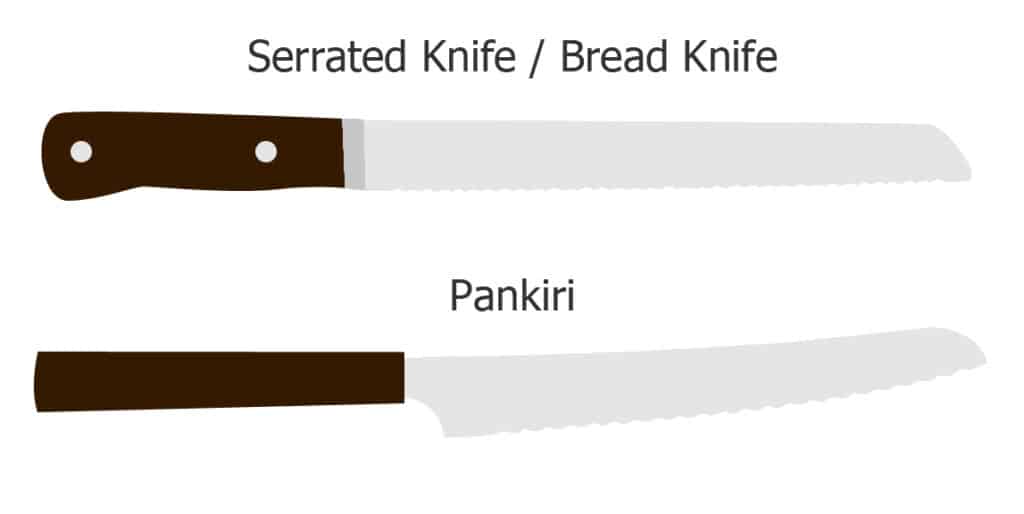
What is a Pankiri
The Pankiri knife ranges between 200 and 250 millimetres, that’s around 8 to 10 inches. It’s a long knife with a serrated blade edge, usually with a slight curve although some Pankiri blade edges are completely straight.
Here’s another comparison table showing the length in millimetres and inches.
| Millimetres | Inches |
| 200 | 8 inches |
| 230 | 9 inches |
| 250 | 10 inches |
Why you need a Pankiri
Pankiri knives are most similar to the western bread knife. They are the perfect tool for slicing baked goods. The serrated edge is perfect for sawing through food with a harder outer crust and soft interior.
Smooth blades struggle with this type of texture but the teeth-like edge of a Pankiri easily cut through hard crusts and the super sharp inside edges of the blade teeth slice through the softer middle.
How to use a Pankiri
Using a Pankiri is super easy. Simply hold the handle in your palm, not need for any ‘choking the blade’ techniques. Start with the tip end of the blade touching the food and slice forward and down, if you don’t cut all the way through then continue to move down and back towards you.
A Pankiri will likely cut through a loaf of bread in one or two slices.
How much you should spend on a Pankiri
A Pankiri is by no means an essential Japanese knife to have. I’ve done this list in order to I think if you’re just getting into Japanese knives then the Gyutou and Petty are the ones you should begin with as they are the most useful for all kinds of cooking.
So I’m going to recommend two Pankiri’s and different prices.
The first is the Seki knife. It’s really cost-effective, good quality and it’s a great introduction to the Pankiri.
The second is the Shun Classic 9”. This is a little bit more expensive but the quality is fantastic. It’s super sharp and stunning.
Sujihiki / Carving knife
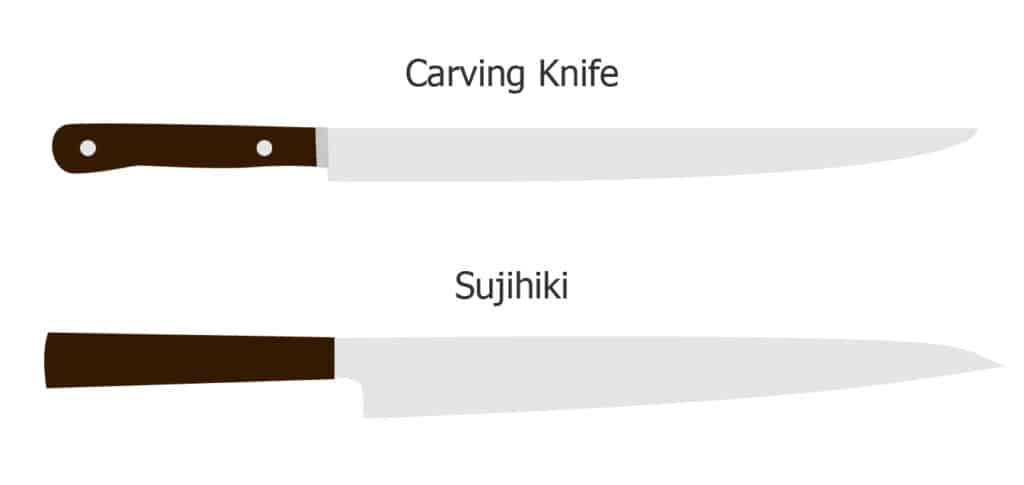
What is a Sujihiki
The Sujihiki is a beautiful knife. It’s probably what a lot of people picture in their mind when they think of a Japanese knife. They are long knives, ranging from 210 to 360 millimetres in length, or 8 to 14 inches.
The blade edge is smooth and sharp with a slight curve. The blade itself is very thin with a low angle of the blade for extra sharpness.
You’ll find the length descriptions are often in millimetres, so here’s a handy table if you’re most familiar with inches.
| Millimetres | Inches |
| 210 | 8 |
| 240 | 9.5 |
| 270 | 10.5 |
| 300 | 12 |
| 360 | 14 |
Why you need a Sujihiki
Sujihiki knives are ideal for carving. The blade is sharp, thin and long, making it perfect for long, accurate slices through meat and fish.
The Sujihiki is a great knife for filleting, trimming and carving meat and fish. It’s also particularly important in raw fish preparation which is of course very popular in Japan for foods such as Sushi. The sharp thin blade minimises the stress on the raw fish when it is cut, maintaining the freshness and flavor.
There are other Japanese knives which specialize in fish preparation, such as the Yanagi, but the Sujihiki is a bit more of an all-rounder knife for filleting and carving, capable of being used for both fish and meat very effectively.
How to use a Sujihiki
Hold the handle in the palm of your hand. If you prefer, for more control you can choke the blade using your index finger and thumb but this isn’t entirely necessary.
Start with the heel end of the blade touching the food and pull the knife backwards and down. The Sujihiki is extremely sharp and long so it’s very effective at slicing, you will likely be able to slice through most food with one long stride.
However, you must be careful of cutting through anything which is likely to contain hard bones. Although Japanese knives are very strong they are also very brittle, so the sudden impact of hitting a bone can chip and damage the blade. These chips can be removed with sharpening but it’s best to try and avoid them altogether.
How much you should spend on a Sujihiki
I would recommend this YOSHIHIRO Sujihiki. It’s a good size at 10.5 inches and it’s very high quality.
I think these knives are absolutely stunning and this one is no exception. It’s a great knife for anyone who wants a quality Japanese selection.
